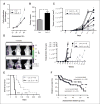CD24 offers a therapeutic target for control of bladder cancer metastasis based on a requirement for lung colonization
- PMID: 21482678
- PMCID: PMC4283788
- DOI: 10.1158/0008-5472.CAN-11-0519
CD24 offers a therapeutic target for control of bladder cancer metastasis based on a requirement for lung colonization
Abstract
Metastasis is lethal in most bladder cancer patients. Expression of CD24, a glycosyl phosphatidylinositol (GPI)-linked sialoglycoprotein and cancer stem cell marker, is associated with metastatic progression in multiple cancer types, yet the role of CD24 in this process remains unclear. While developing a murine model of human metastatic bladder cancer, we observed that tumor cell CD24 expression correlated with a propensity to metastasize to the lung. Our immunohistochemical evaluation of 60 paired primary and metastatic human bladder cancer samples revealed increased intensity (P < 0.001) and frequency (P < 0.001) of CD24 expression in metastases. To directly evaluate the role of CD24 in metastatic colonization, we manipulated CD24 expression in human bladder cancer cell lines using short hairpin RNA depletion, cDNA overexpression, and fluorescence-activated cell sorting selection. Although suppression of CD24 reduced acute tumor cell retention in the lungs of mice inoculated intravenously with cancer cells, this differential retention was no longer apparent after 24 hours, prompting us to evaluate the role of CD24 in lung colonization. Here, CD24 was found necessary for subsequent development of lung metastases. We next treated clinically detectable lung metastases in mice with anti-CD24 antibody and observed reduced tumor growth and prolonged survival. These findings suggest that CD24 is a lynchpin of metastatic progression and a promising therapeutic target for antimetastatic therapy.
Conflict of interest statement
No potential conflicts of interest were disclosed.
Figures




References
-
- Wallmeroth A, Wagner U, Moch H, Gasser TC, Sauter G, Mihatsch MJ. Patterns of metastasis in muscle-invasive bladder cancer (pT2–4): an autopsy dtudy on 367 patients. Urol Int. 1999;62:69–75. - PubMed
-
- von der Maase H, Hansen SW, Roberts JT, Dogliotti L, Oliver T, Moore MJ, et al. Gemcitabine and cisplatin versus methotrexate, vinblastine, doxorubicin, and cisplatin in advanced or metastatic bladder cancer: results of a large, randomized, multinational, multicenter, phase III study. J Clin Oncol. 2000;18:3068–77. - PubMed
-
- Nguyen DX, Bos PD, Massague J. Metastasis: from dissemination to organ-specific colonization. Nat Rev Cancer. 2009;9:274–84. - PubMed
-
- Vale C. Neoadjuvant chemotherapy in invasive bladder cancer: a systematic review and meta-analysis. Lancet. 2003;361:1927–34. - PubMed
-
- Pirruccello SJ, LeBien TW. The human B cell-associated antigen CD24 is a single chain sialoglycoprotein. J Immunol. 1986;136:3779–84. - PubMed
Publication types
MeSH terms
Substances
Grants and funding
LinkOut - more resources
Full Text Sources
Other Literature Sources
Medical
Research Materials

